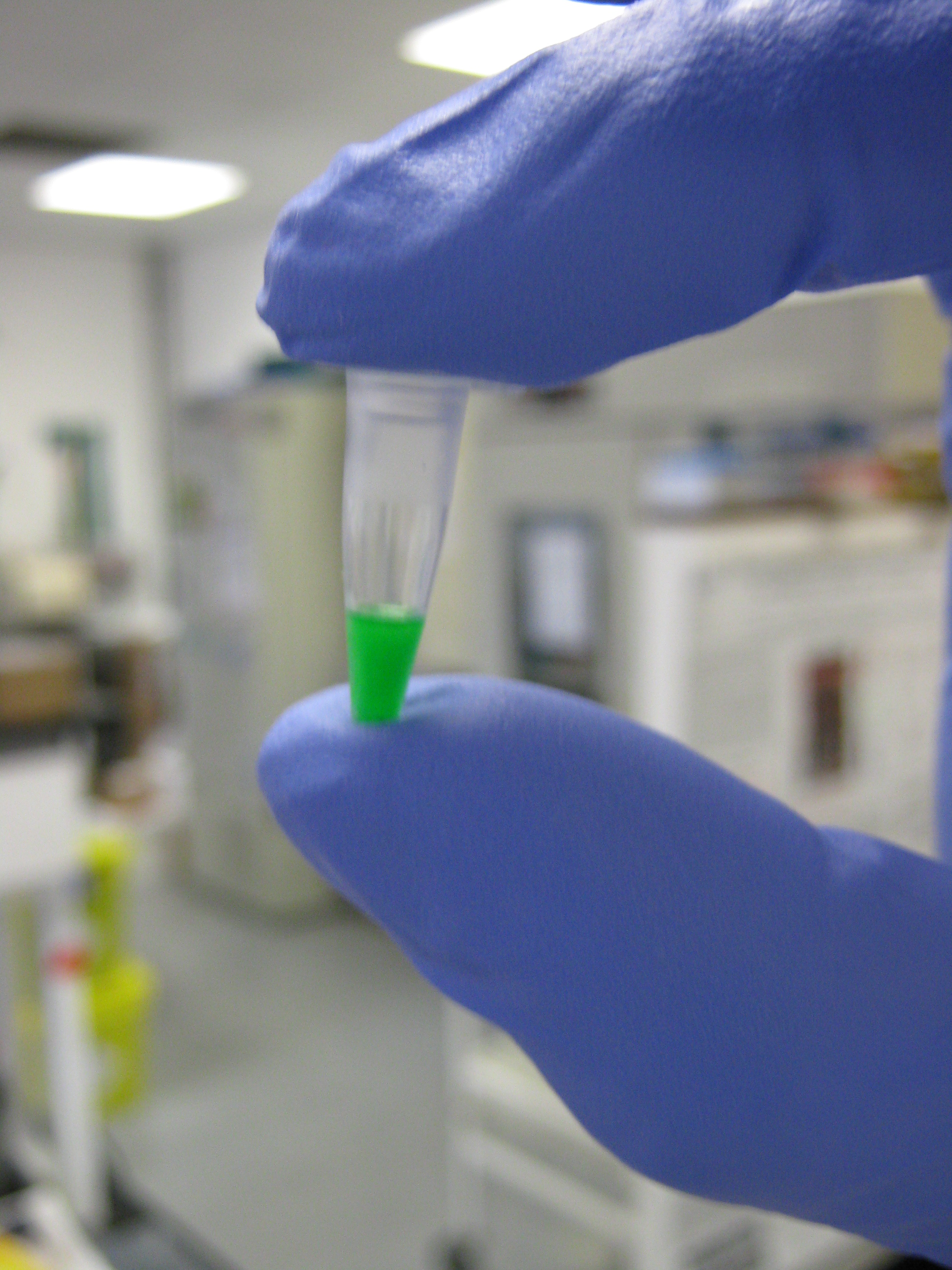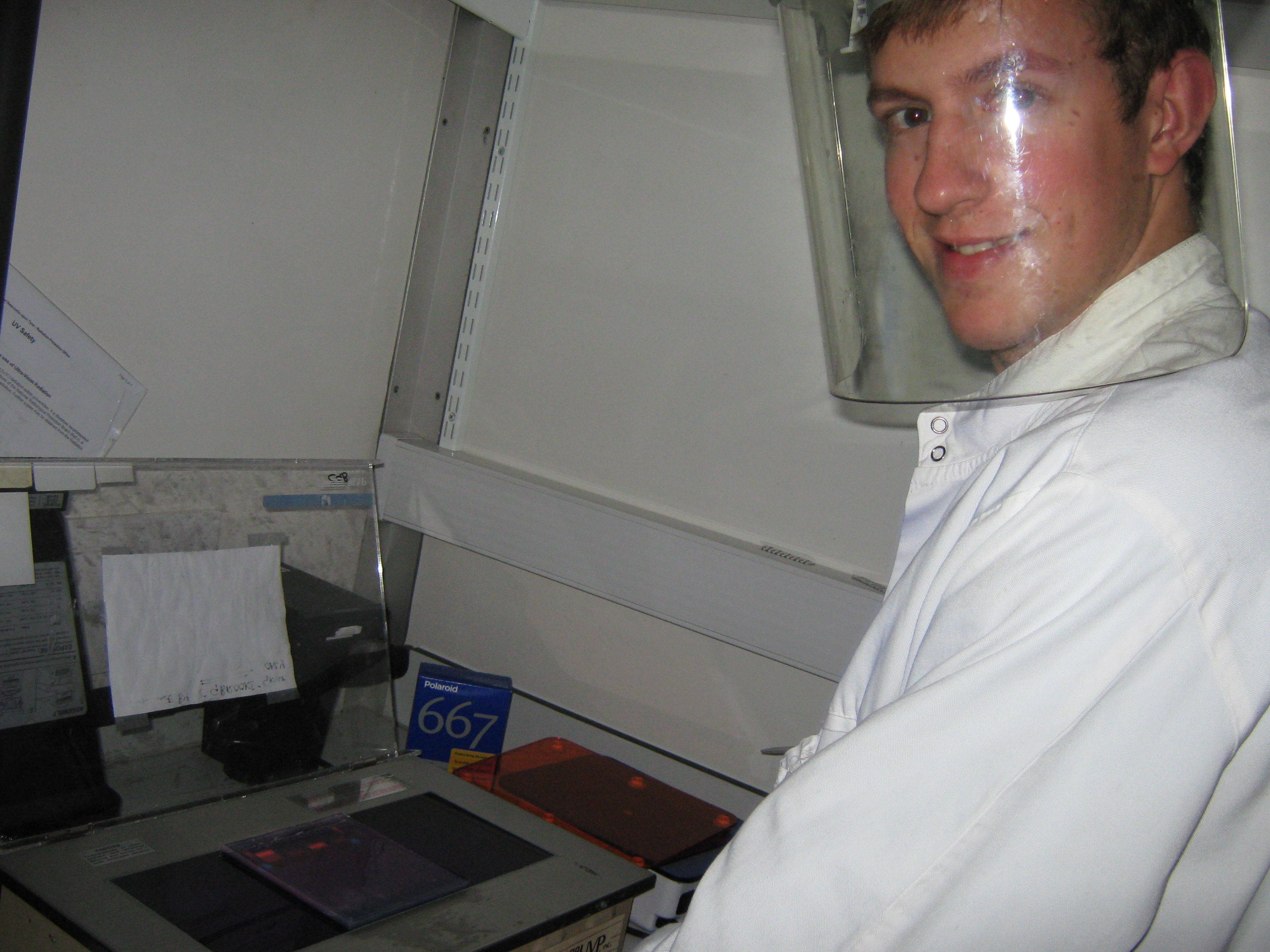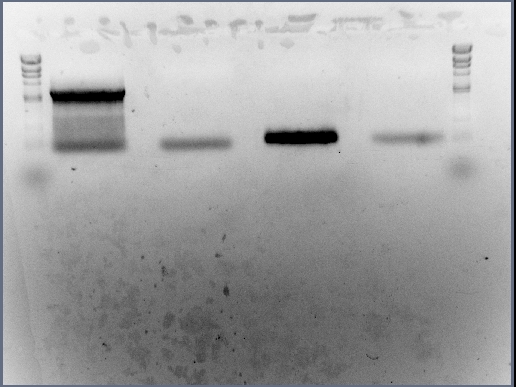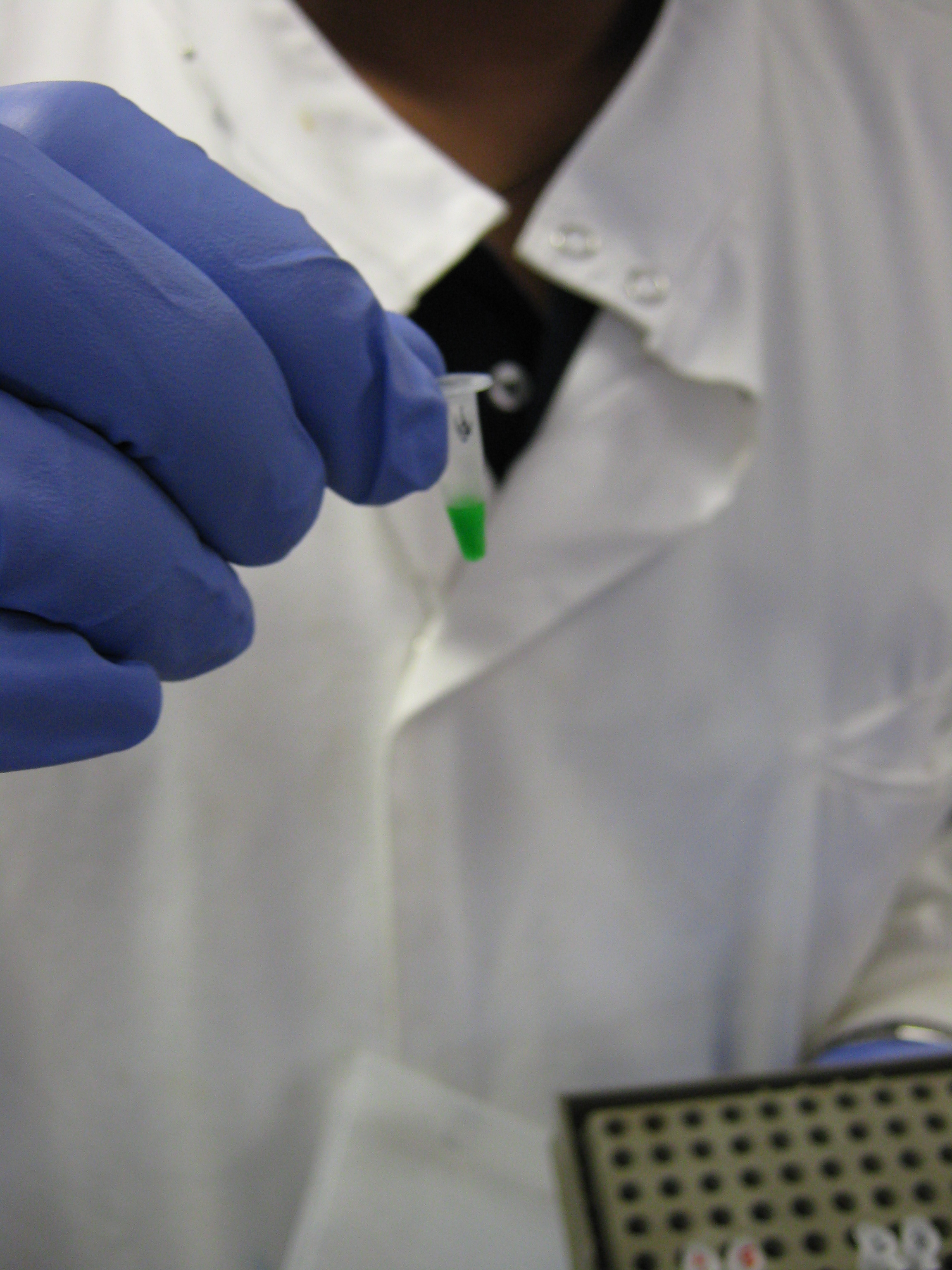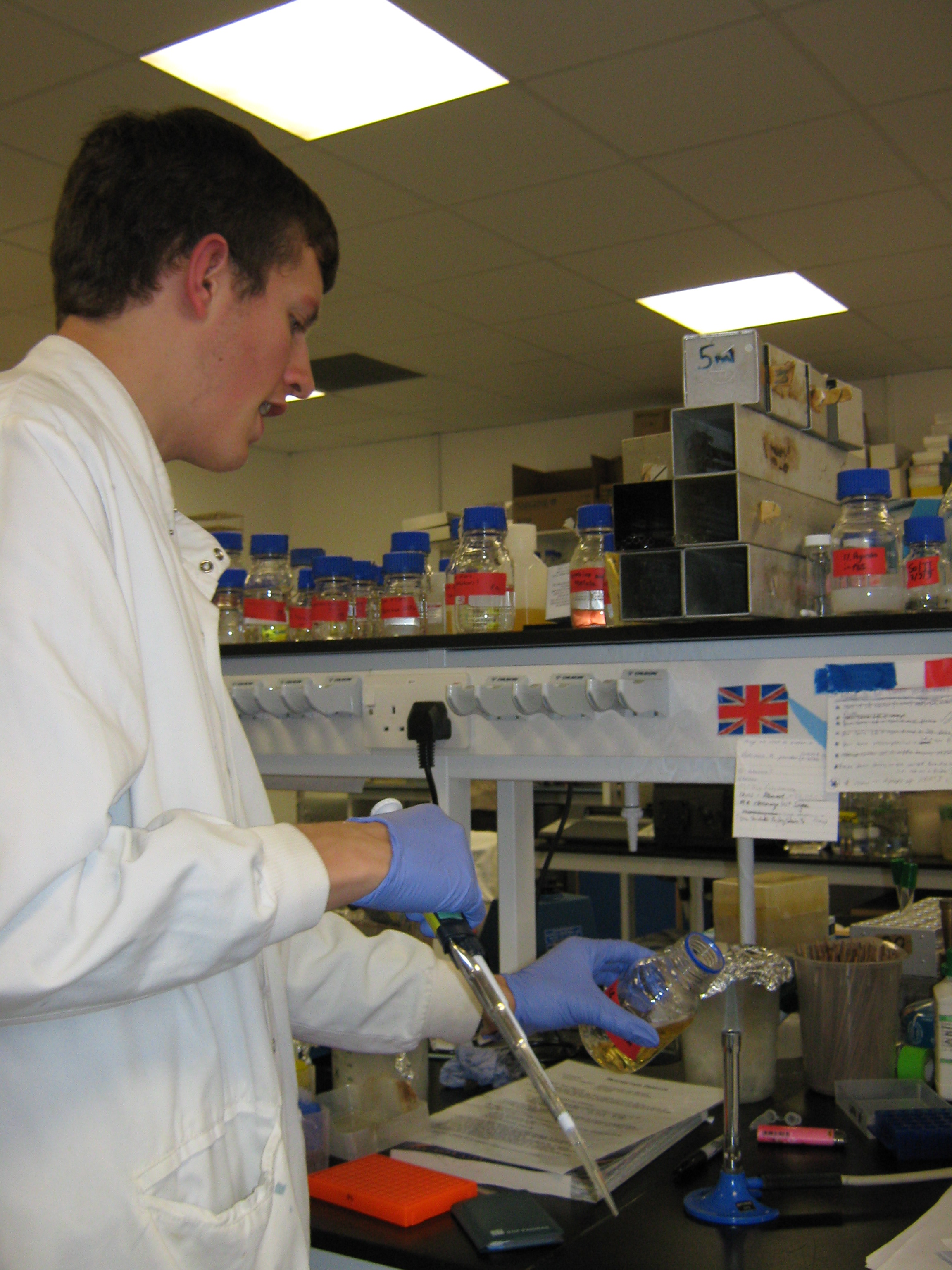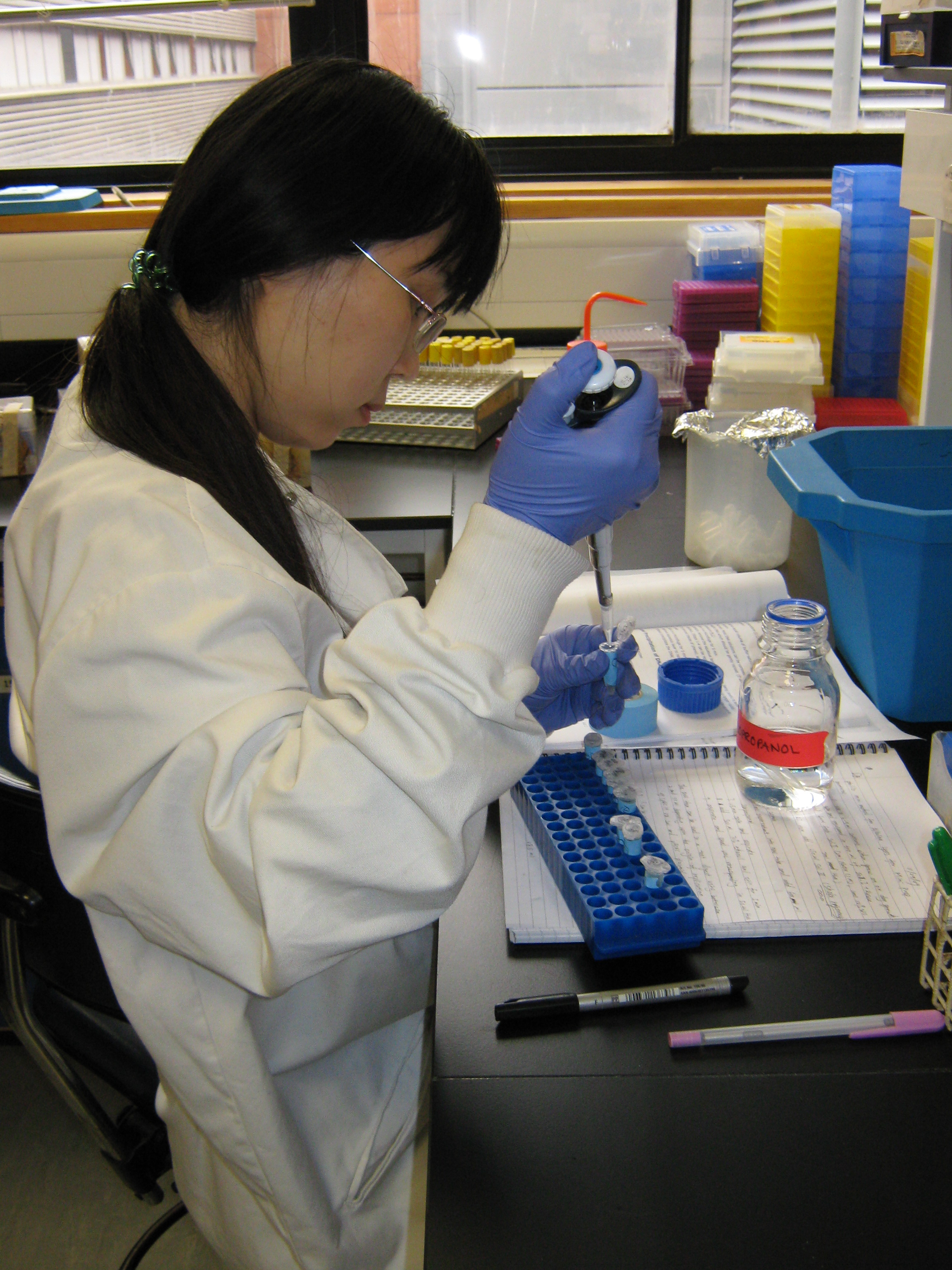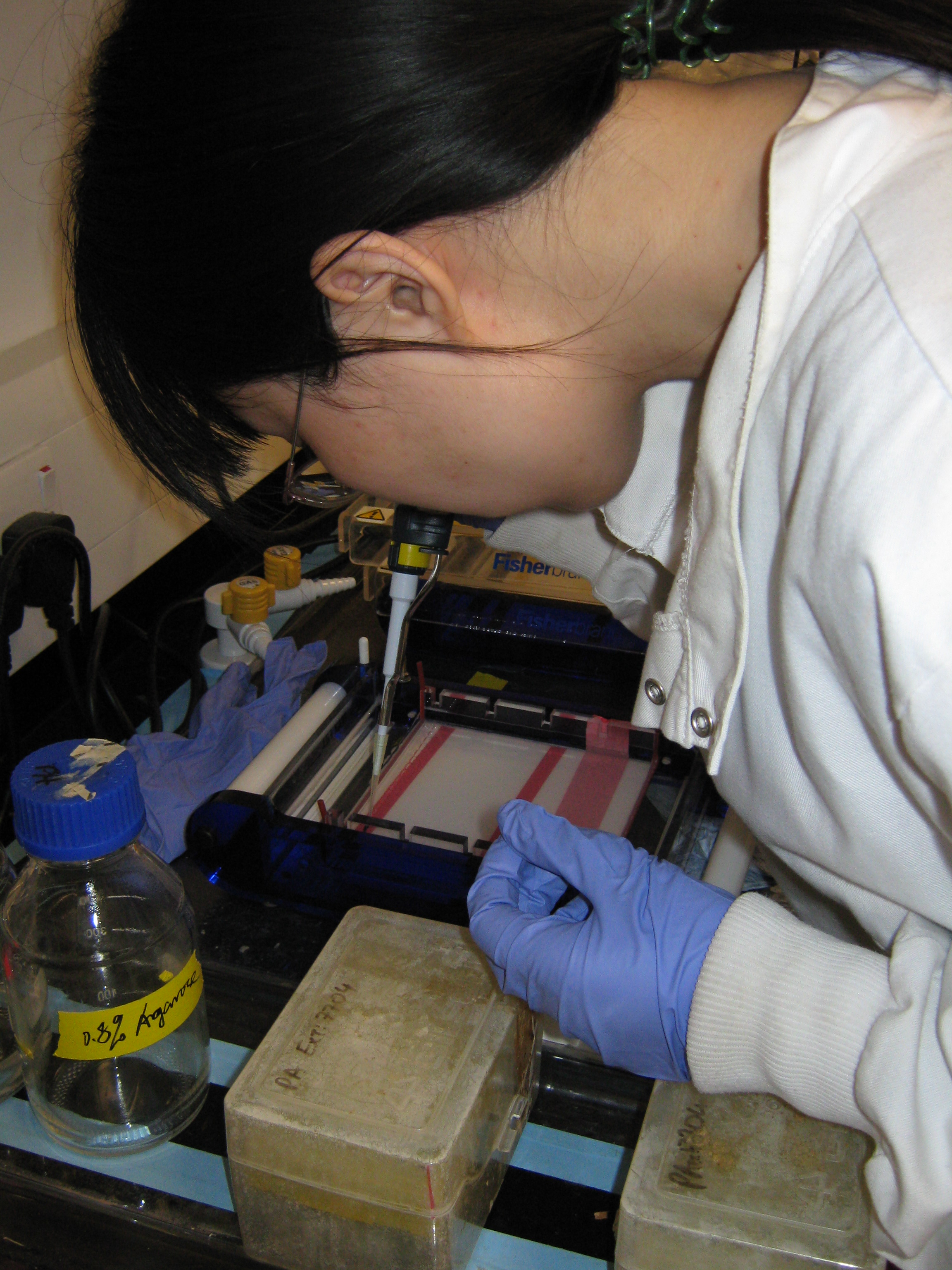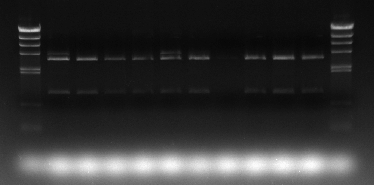Team:Newcastle/Labwork/14 September 2009
From 2009.igem.org
(→Chassis team) |
Babyneurone (Talk | contribs) (→1) Cadmium-sensing logic AND gate) |
||
| (21 intermediate revisions not shown) | |||
| Line 5: | Line 5: | ||
[[Image:Team Newcastle 2009 iGEM ProbationaryP-Sign.PNG|50px|right]] | [[Image:Team Newcastle 2009 iGEM ProbationaryP-Sign.PNG|50px|right]] | ||
=Formal Lab Session - 14th September 2009= | =Formal Lab Session - 14th September 2009= | ||
| - | ==<u>Metal | + | [[Image:Team Newcastle 2009 iGEM 14-09-09 IMG 1131.JPG|300px|center]] |
| + | <br> | ||
| + | =<font color="Orange"><u>Overview</u></font>= | ||
| + | <font color="Orange"> | ||
| + | *[[#Metal Sensor Team|Metal Sensor Team]] '''- ''' | ||
| + | <br> | ||
| + | *[[#Sporulation Tuning/Chassis Team|Sporulation Tuning/Chassis Team]] '''- ''' | ||
| + | <br> | ||
| + | </font> | ||
| + | <br> | ||
| + | ==<u>Metal Sensor team</u>== | ||
===Introduction=== | ===Introduction=== | ||
In the last lab session the team carried out a successful PCR reaction on the ''cotC-GFP-smtA'' BioBrick and cleaned up the products. The team also midi-prepped ''cotC-GFP-smtA'', ''kinA'', ''pGFP-rrnB'', ''pMUTIN4'' and ''pSB1AT3'' which will prove useful for other team members too. In addition, transformant ''E. coli'' cells containing the ''kinA'' BioBrick and the ''cotC-GFP-smtA'' BioBrick were grown up in 5ml LB cultures and then frozen down. | In the last lab session the team carried out a successful PCR reaction on the ''cotC-GFP-smtA'' BioBrick and cleaned up the products. The team also midi-prepped ''cotC-GFP-smtA'', ''kinA'', ''pGFP-rrnB'', ''pMUTIN4'' and ''pSB1AT3'' which will prove useful for other team members too. In addition, transformant ''E. coli'' cells containing the ''kinA'' BioBrick and the ''cotC-GFP-smtA'' BioBrick were grown up in 5ml LB cultures and then frozen down. | ||
| + | |||
However there were also things that we didn't accomplish. We had previously carried out a PCR reaction involving the two elements of our cadmium-sensitive logic AND gate - ''arsR'' and ''cadA''. But when the products were cleaned a large amount of ethanol remained in the sample and so when placed into agarose gel the sample dispersed. We then proceded to carry out a second attempt at the same PCR reaction. | However there were also things that we didn't accomplish. We had previously carried out a PCR reaction involving the two elements of our cadmium-sensitive logic AND gate - ''arsR'' and ''cadA''. But when the products were cleaned a large amount of ethanol remained in the sample and so when placed into agarose gel the sample dispersed. We then proceded to carry out a second attempt at the same PCR reaction. | ||
| Line 16: | Line 27: | ||
Today's lab session will continue straight on from the last lab session and fulfil the following objectives: | Today's lab session will continue straight on from the last lab session and fulfil the following objectives: | ||
<br> | <br> | ||
| + | [[Image:Team Newcastle 2009 iGEM 14-09-09 IMG 1136.JPG|200px|right]] | ||
# Run products of PCR reaction involving the ''arsR'' BioBrick (''BBa_J33206'' in ''pSB1A2'' missing promoter) and ''cadA'' promoter region | # Run products of PCR reaction involving the ''arsR'' BioBrick (''BBa_J33206'' in ''pSB1A2'' missing promoter) and ''cadA'' promoter region | ||
## If successful clean up product, run on agarose gel through electrophoresis, excise band and carry out gel extraction. | ## If successful clean up product, run on agarose gel through electrophoresis, excise band and carry out gel extraction. | ||
| Line 32: | Line 44: | ||
All of the DNA from the PCR reactions involving the ''cadA'' promoter region and the ''arsR'' BioBrick (''BBa_J33206'' without promoter) was inserted into agarose gel (in two separate wells of course) and DNA gel electrophoresis allowed to commence for 20 minutes under 80 volts. | All of the DNA from the PCR reactions involving the ''cadA'' promoter region and the ''arsR'' BioBrick (''BBa_J33206'' without promoter) was inserted into agarose gel (in two separate wells of course) and DNA gel electrophoresis allowed to commence for 20 minutes under 80 volts. | ||
| + | [[Image:Team Newcastle 2009 iGEM 14-09-09 IMG 1128.JPG|200px|right]] | ||
We also ran ''ara'' and ''pGFP-rrnB'' DNA on the gel (this is for the Stochastic Switch team). | We also ran ''ara'' and ''pGFP-rrnB'' DNA on the gel (this is for the Stochastic Switch team). | ||
| Line 75: | Line 88: | ||
|} | |} | ||
<br> | <br> | ||
| + | |||
The two fragments then underwent a FastLigation reaction. This ligation only took 10 minutes. This is what we inserted into the ligation reaction: | The two fragments then underwent a FastLigation reaction. This ligation only took 10 minutes. This is what we inserted into the ligation reaction: | ||
<br> | <br> | ||
| Line 117: | Line 131: | ||
<br> | <br> | ||
==== 3) Transforming ''E. coli'' cells with two ligated products ==== | ==== 3) Transforming ''E. coli'' cells with two ligated products ==== | ||
| + | [[Image:Team Newcastle 2009 iGEM 14-09-09 IMG 1151.JPG|200px|right]] | ||
The two ligated products - the ''arsR''-''cadA'' promoter AND gate and the ''cotC-GFP-smtA'' BioBrick in ''pMUTIN4'' - were then transformed into ''DH5-alpha'' ''E. coli'' cells using [https://2009.igem.org/Team:Newcastle/Project/Labwork/PhilsProtocols#Transforming_DNA_.22Phil_Style.22 Phil's transformation by heat shock protocol]. There were only two changes to the protocol: | The two ligated products - the ''arsR''-''cadA'' promoter AND gate and the ''cotC-GFP-smtA'' BioBrick in ''pMUTIN4'' - were then transformed into ''DH5-alpha'' ''E. coli'' cells using [https://2009.igem.org/Team:Newcastle/Project/Labwork/PhilsProtocols#Transforming_DNA_.22Phil_Style.22 Phil's transformation by heat shock protocol]. There were only two changes to the protocol: | ||
<br> | <br> | ||
| Line 124: | Line 139: | ||
All of the DNA from the ligation reactions was added to the competent cells. Once the ligations were completed, the cells were plated onto LB + antibiotic plates. The ''arsR''-''cadA'' promoter transformants were plated on LB + ampicillin plates whereas the ''cotC-GFP-smtA'' BioBrick in ''pMUTIN4'' transformant cells were plated on LB + chloramphenicol plates. | All of the DNA from the ligation reactions was added to the competent cells. Once the ligations were completed, the cells were plated onto LB + antibiotic plates. The ''arsR''-''cadA'' promoter transformants were plated on LB + ampicillin plates whereas the ''cotC-GFP-smtA'' BioBrick in ''pMUTIN4'' transformant cells were plated on LB + chloramphenicol plates. | ||
| - | + | ==<u>Sporulation Tuning/Chassis Team</u>== | |
| - | ==<u> Chassis | + | |
===Introduction=== | ===Introduction=== | ||
| Line 136: | Line 150: | ||
===Experiment procedure=== | ===Experiment procedure=== | ||
| - | + | [[Image:Team Newcastle 2009 iGEM 14-09-09 IMG 1125.JPG|200px|right]] | |
==== Mini Prep ==== | ==== Mini Prep ==== | ||
* We have cultured 10 colonies which can grow on the LB+Amp+Tet plate. | * We have cultured 10 colonies which can grow on the LB+Amp+Tet plate. | ||
| Line 184: | Line 198: | ||
==== Gel extraction of digested DNA ==== | ==== Gel extraction of digested DNA ==== | ||
| + | [[Image:Team Newcastle 2009 iGEM 14-09-09 IMG 1145.JPG|200px|right]] | ||
* Pour the big well gel before digestion was finished. | * Pour the big well gel before digestion was finished. | ||
* After 1 hour digestion of cwlJ and sleB PCR products, we loaded the digested DNA in big well. | * After 1 hour digestion of cwlJ and sleB PCR products, we loaded the digested DNA in big well. | ||
* 90 volt, run for 30 - 45 mins. | * 90 volt, run for 30 - 45 mins. | ||
| - | * Check the result | + | * Check the result under UV light. |
* Cut the right band and purified sleB and cwlJ DNA from agarose gel using Gel Extraction Kit(Sigma). | * Cut the right band and purified sleB and cwlJ DNA from agarose gel using Gel Extraction Kit(Sigma). | ||
==== Midi culture colony which contains right sleB clone ==== | ==== Midi culture colony which contains right sleB clone ==== | ||
* Take out 200ul cells from Mini prep tube.(there should have 3.5ml cells left after Mini prep) | * Take out 200ul cells from Mini prep tube.(there should have 3.5ml cells left after Mini prep) | ||
| + | |||
| + | Strain 1 was select here. | ||
===Conclusion=== | ===Conclusion=== | ||
| Line 197: | Line 214: | ||
<br> | <br> | ||
| - | [[Image:|400px|center]] | + | [[Image:Team_newcastle_2009_igem_hjgel_140909_sleB.png |400px|thumb|center|sleB Mini Prep result]] |
===Futher plan=== | ===Futher plan=== | ||
| + | * Culture one strain for Midi Prep. | ||
| + | * Ligation cwlJ and pSB1AT3 and do the transformation. | ||
| + | * Ligation cwlJ with pSB1AT3:sleb to obtain a double clone. | ||
{{:Team:Newcastle/Project/Labwork/CalTemplate}} | {{:Team:Newcastle/Project/Labwork/CalTemplate}} | ||
Latest revision as of 12:16, 20 August 2010
Formal Lab Session - 14th September 2009
Overview
Metal Sensor team
Introduction
In the last lab session the team carried out a successful PCR reaction on the cotC-GFP-smtA BioBrick and cleaned up the products. The team also midi-prepped cotC-GFP-smtA, kinA, pGFP-rrnB, pMUTIN4 and pSB1AT3 which will prove useful for other team members too. In addition, transformant E. coli cells containing the kinA BioBrick and the cotC-GFP-smtA BioBrick were grown up in 5ml LB cultures and then frozen down.
However there were also things that we didn't accomplish. We had previously carried out a PCR reaction involving the two elements of our cadmium-sensitive logic AND gate - arsR and cadA. But when the products were cleaned a large amount of ethanol remained in the sample and so when placed into agarose gel the sample dispersed. We then proceded to carry out a second attempt at the same PCR reaction.
In today's practical we hope to ligate pMUTIN4 and the cotC-GFP-smtA BioBrick together - firstly cutting both fragments with BamHI and HindIII and then ligating the DNA together. We also hope to run the arsR and cadA promoter PCR products on agarose gel (in DNA gel electrophoresis) and if successful, clean up the sample. Then run all of the sample through agarose gel and excise the band produced, also extracting the gel from it afterwards. If all these events happen, we will also cut both the arsR and cadA fragments with BamHI and NheI and attempt overnight ligation.
Practical Outline
Today's lab session will continue straight on from the last lab session and fulfil the following objectives:
- Run products of PCR reaction involving the arsR BioBrick (BBa_J33206 in pSB1A2 missing promoter) and cadA promoter region
- If successful clean up product, run on agarose gel through electrophoresis, excise band and carry out gel extraction.
- Cut cleaned and excised fragment with BamHI and NheI
- Carry out ligation (possibly an overnight ligation)
- Cut pMUTIN4 and cotC (i.e. PCR product 3) with BamHI and HindIII
- Ligate the fragments (possibly overnight)
Procedure
1) Cadmium-sensing logic AND gate
The first step to take was to run the PCR products of reactions involving the arsR BioBrick (BBa_J33206 without it's original promoter) and the cadA promoter region through agarose gel in DNA gel electrophoresis. The initial views of the team was to carry out a test on the samples on some gel before excising the rest of the DNA when in gel. However we decided to place all of the DNA into gel and excise the band immediately, without conducting tests.
All of the DNA from the PCR reactions involving the cadA promoter region and the arsR BioBrick (BBa_J33206 without promoter) was inserted into agarose gel (in two separate wells of course) and DNA gel electrophoresis allowed to commence for 20 minutes under 80 volts.
We also ran ara and pGFP-rrnB DNA on the gel (this is for the Stochastic Switch team).
The bands were then excised and cleaned using Sigma-Aldrich's GenElute Gel Extraction kit (along with the protocol). There was no changes to the protocol but a few important points to note:
- The 'Spin Method' was the preferred route in the protocol to follow.
- The mass of the gel bands were as follows:
- arsR band = 0.285 grams
- cadA promoter region band = 0.354 grams
- ara band = 0.212 grams
- pGFP-rrnB band = 0.233 grams
- arsR band = 860ul of solution to be added
- cadA promoter region band = 1060ul of solution to be added
- ara band = 640ul of solution to be added
- pGFP-rrnB band = 700ul of solution to be added
- arsR band = 285ul of isopropanol to be added
- cadA promoter region band = 354ul of isopropanol to be added
- ara band = 212ul of isopropanol to be added
- pGFP-rrnB band = 233ul of isopropanol to be added
Once the arsR (the BBa_J33206 BioBrick without promoter region) and cadA promoter DNA samples were cleaned, they were both cut using BamHI and NheI in the following way:
| arsR BioBrick | cadA promoter | ||
|---|---|---|---|
| DNA (ul) | 10 | 10 | |
| Restriction Buffer (ul) | 2 | 2 | |
| BamHI Restriction Enzyme(ul) | 1 | 1 | |
| NheI Restriction Enzyme(ul) | 1 | 1 | |
| Distilled water(ul) | 6 | 6 |
The two fragments then underwent a FastLigation reaction. This ligation only took 10 minutes. This is what we inserted into the ligation reaction:
- Linearised vector DNA = BBa_J33206 (arsR) without promoter - 1ul
- Insert DNA = cadA promoter region - 7ul
- 5x Rapid Ligation Buffer = 4ul
- Water = 6ul
- T4 DNA ligase = 1ul
Note: cadA promoter region DNA concentration was 17ng/ul; arsR BioBrick DNA concentration was 40ng/ul
2) Ligating the cotC BioBrick with pMUTIN4
Firstly the cotC BioBrick and the pMUTIN4 DNA was cut with BamHI and HindIII:
| cotC BioBrick (reaction 1) | cotC BioBrick (reaction2) | pMUTIN4 plasmid | ||
|---|---|---|---|---|
| DNA (ul) | 30 | 10 | 20 | |
| Restriction Buffer (ul) | 5 | 5 | 5 | |
| BamHI Restriction Enzyme(ul) | 1 | 1 | 1 | |
| HindIII Restriction Enzyme(ul) | 1 | 1 | 1 | |
| Distilled water(ul) | 13 | 33 | 23 |
These digests were left to commence for 1 hour. Once this time had elapsed the two fragments of DNA were ligated together in the following way:
- 1ul of pMUTIN4
- 6ul of cotC
- 4ul of buffer solution
- 1ul DNA ligase
- 7ul sterile distilled water
3) Transforming E. coli cells with two ligated products
The two ligated products - the arsR-cadA promoter AND gate and the cotC-GFP-smtA BioBrick in pMUTIN4 - were then transformed into DH5-alpha E. coli cells using Phil's transformation by heat shock protocol. There were only two changes to the protocol:
- For step 2 - the waiting time was 15 minutes instead of 30 minutes
- For step 5 - the waiting time was also 15 minutes instead of 30 minutes.
All of the DNA from the ligation reactions was added to the competent cells. Once the ligations were completed, the cells were plated onto LB + antibiotic plates. The arsR-cadA promoter transformants were plated on LB + ampicillin plates whereas the cotC-GFP-smtA BioBrick in pMUTIN4 transformant cells were plated on LB + chloramphenicol plates.
Sporulation Tuning/Chassis Team
Introduction
- Since we have got the colonys from sleB transformation, and we cultured 5ml overnight cells yesterday. Finally, we can carry out a Mini prep to check our result for transformation.
- In case our transformation didn't work, we prepare digested sleB fragment as a backup.
- For cwlJ Biobrick, we need to digest cwlJ PCR product and do another transformation.
Experiment procedure
Mini Prep
- We have cultured 10 colonies which can grow on the LB+Amp+Tet plate.
- After overnight grow, we perform the Mini Prep to select the right colony which contains sleB clone.
- The Mini Prep experiment followed the Phil's Mini Prep protocal
Fast digest Mini prep result
- This digest is the simple test of our sleB transformation result, we use 20ul for the final volume.
ddH2o 7.0ul
10X fast digest buffer 2ul
Mini prep DNA 10ul
Restriction enzyme 1 0.5ul
Restriction enzyme 2 0.5ul
-------------------------------------
Total: 20ul
- Here the restriction enzyme 1 and 2 were the same enzyme used for the digestion of sleB PCR result: EcoRI and speI.
- 37C 1 hour.
- After one hour digestion, we loaded 10 digested samples in 0.8% agarose gel, 90v 30 - 45 mins.
- Scanned the electrophoresis result in UV light.
Digest cwlJ and sleB PCR products
This digestion was carried out for the ligation and transformation.
- sleB digestion: sleB DNA has been cleaned up by PCR Clean up Kit after PCR.
dd H2O 7ul
10X fast digest buffer 7ul
Fast EcoRI 3ul
Fast speI 3ul
sleB DNA 50ul
------------------------------
70ul
- cwlJ digestion: cwlJ DNA has been cleaned up by PCR Clean up Kit after PCR.
dd H2O 7ul
10X fast digest buffer 7ul
Fast EcoRI 3ul
Fast speI 3ul
sleB DNA 50ul
------------------------------
70ul
Gel extraction of digested DNA
- Pour the big well gel before digestion was finished.
- After 1 hour digestion of cwlJ and sleB PCR products, we loaded the digested DNA in big well.
- 90 volt, run for 30 - 45 mins.
- Check the result under UV light.
- Cut the right band and purified sleB and cwlJ DNA from agarose gel using Gel Extraction Kit(Sigma).
Midi culture colony which contains right sleB clone
- Take out 200ul cells from Mini prep tube.(there should have 3.5ml cells left after Mini prep)
Strain 1 was select here.
Conclusion
- The electrophoresis result after digestion showed that 9 colonies had got the sleB clone successfully.
Futher plan
- Culture one strain for Midi Prep.
- Ligation cwlJ and pSB1AT3 and do the transformation.
- Ligation cwlJ with pSB1AT3:sleb to obtain a double clone.
|
| |||||||||||||||||||||||||||||||||||||||||||||||||||||||||||||||||||||||||||||||||||||||||||||||||
|
| |||||||||||||||||||||||||||||||||||||||||||||||||||||||||||||||||||||||||||||||||||||||||||||
News
Events
- 20 – 21 June 2009 - Europe workshop (London)
- 23 – 24 June 2009 - UK iGEM meetup (Edinburgh)
- 23 October Practice Presentation (Newcastle)
- 23 October T-shirts are ready
- 27 October Practice Presentation (Sunderland)
- 27 October Poster is ready
- 30 October – 2 November 2009 - Jamboree (Boston)
Social Net
- Newcastle iGEM Twitter
- [http://www.facebook.com/home.php#/group.php?gid=131709337641 Newcastle on Facebook]
- [http://www.youtube.com/user/newcastle2009igem Newcastle Youtube Channel]
 "
"

